February, 2023 by Made Victor of Bali. (Made Victor is the Bali name of writer Zephyr Carlyle) Here is a common Bali experience: Upon stumbling onto some new location, I often exclaim, “This is one of the most beautiful places I have ever been to!” I had the same sensation when peering at the Temple studded shoreline of Tanah Lot. But this time I really meant it — Tanah Lot is one of the most beautiful of places. The “Temple studded shoreline” part is also not an exaggeration. Tanah Lot means Land in The Sea. Tanah Lot has three separate Temples, two of which are cantilevered out over the ocean. The third Temple hugs the shoreline atop a rocky outcropping. These rock-ribbed Temples have solid foundations, but only God can keep them upright in the face of the daily onslaught of crashing waves, tides, shifting sands, and the occasional cyclone. The Temple location below may look like it would be dire straits during any potential earthquake or other natural disaster. However, I would feel safer being evacuated to Tanah Lot Temple than an emergency shelter in a school gym. Yet, Tanah Lot has a huge multi-use, layered facility and is the perfect place to lay out Bali Temple traditions such as: a sacred natural setting; mystic, supernatural origins; a sacred guard animal; multi-tiered religious facilities; the function of supplicant’s offering; and more.
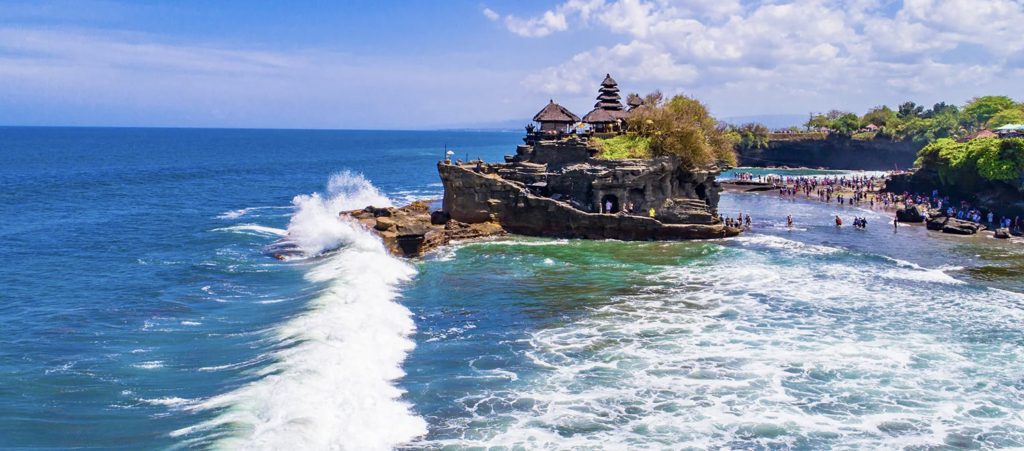
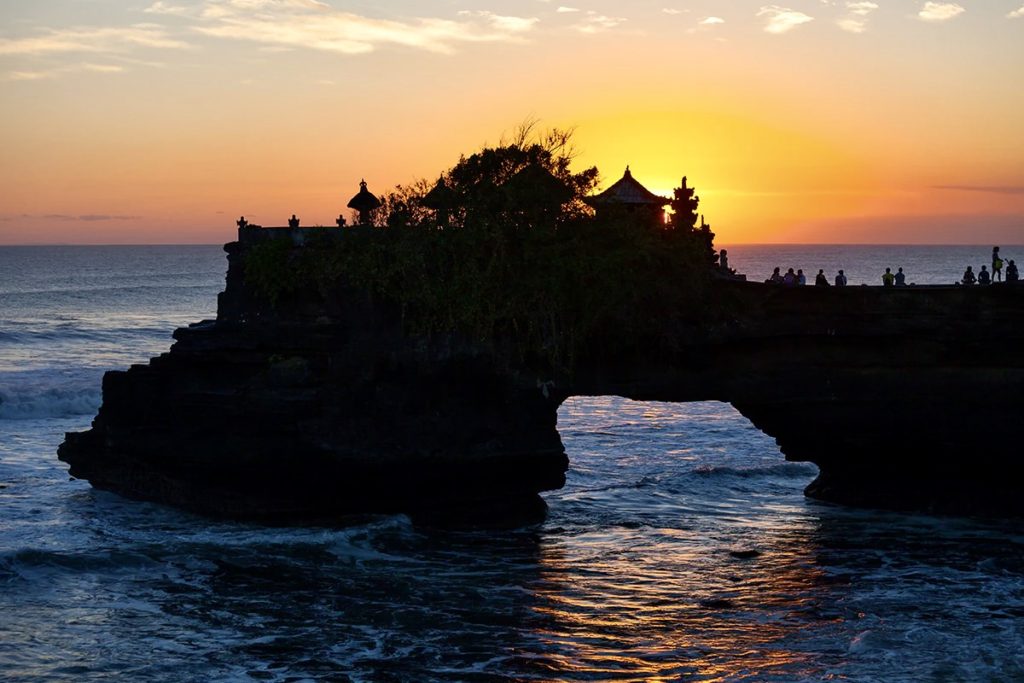
Tanah Lot Historic Origins
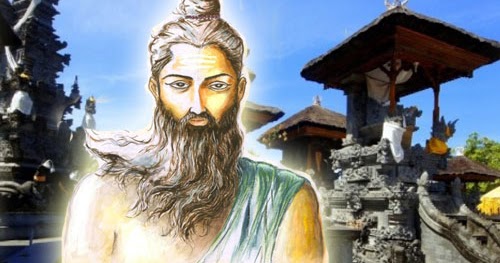
Tanah Lot was created by Dang Hyang Nirartha, a famed 16th century holy man with supernatural powers. He was also founded Pura Besakih, the Mother of All Bali Temples. This guy was busy.
Dang Hyang Nirartha’s original vision was to build a three-temple system based on the main Hindu Gods, all for Balinese villages neighboring the area where Tanah Lot exists now. His original plan was to build a Temple in the northern area of the village for Hindu God Brahma, a middle area Temple for Vishnu and the southern Temple for Shiva. While traveling through this area, he saw the little rock hillock and decided to spend the night on the plateau. Dang Hyang Nirartha had an enlightenment, that this rocky height was a holy place to build a shrine. The village leader was angry and ordered people to banish Nirartha from the rock heights. In response, Nirartha uses his supernatural power to move the whole rock reserve out to the sea. Now the sacred site was protected and safe. Nirartha was free to build his temples and he named them Tanah Lot. The neighboring villagers were astounded and all followed Nirartha in Hindu worship.
The main Tanah Lot temple was built for a second purpose: to worship Bhatara Segara, or the Sea God. To protect the Temple, Bhatara Segara created a poisonous snake from his sash. The sea snake is believed to be living at the base of this rocky island, to guard the temple from evil intruders. We have photos of the sacred snake below.
Tanah Lot is a Combo Site: Sacred Temple and Public Park
Tanah Lot is the weirdest Temple in Bali. How does that claim fit into the article title that Tanah Lot is the perfect example of Bali Temple traditions? Tahah Lot is the exception that proves the rule, at least in this aspect: Temple site function. Tanah Lot and all large, public Temples are like beautiful religious jewels: Temple complex(es) with soaring Indo architecture, elaborate arches, sacred sculptures, and the like. Most Temple compounds are nestled into gorgeous grounds — lush gardens, huge ancient koi ponds, water falls, a grove of sacred banyan trees, or even bamboo fields that started out life as the Temple’s protective walls. Many of these Temples are plunked down in spectacular nature settings; perhaps a river, or jungle, or oceanside, or even a sacred cave. This is largely because the Bali religion retains a lot of pre-Hindu animist traditions in which every tree, fish, river and rock is suffused by God consciousness. Note the Temple founder was a “Holy Man”: He was NOT a Hindu Priest. The Hyang in the name Dang Hyang Nirartha refers to the pre-Hindu Gods, the Hyangs, that once ruled in Bali, before the Hindu Gods arrived. Thus, the Temple sites themselves — the land, the bamboo, the bushes, birds flying overhead, — are the most God-filled, the most holy embodiments of God. The sacred Temples structures complement the already holy nature of the site.
Tanah lot is beautiful ancient architecture built on sacred ground, just like all the others. But Tanah Lot is more. Tanah Lot also functions like a public park. This is the only Temple I know that has such extensive parking lots that it has a guard house as you drive up where you pay the entrance fee. While parking, you can look towards the Temple and espy the rows of souvenir vendors and little restaurants on the periphery of the Temple grounds. These t-shirt and batik merchants, little sidewalk vendors, coffee shops, and convenience stores, (including a Circle K), all partially block the grassy promenades and meandering walkways. The stores completely obscure the Temple complexes ensconced within the belly of the park. Once inside the park, adjacent to Temple structure, there are still more little restaurants and vendors, including the Civet Poop Coffee Cafe noted below. Once past all these ticky-tacky shops, you see the park-like setting that covers a wide strip of land snug against the coastline’s low cliffs. Many religious structures are set out in this park environment; such as the third Temple, pavilions, archways and stairs, and many others, see photos below. the park’s grass lined promenade overlooks the ocean and the two main Temples jutting out into the breakers. Many visitors are enjoying the park who have finished their Temple experience (or perhaps never step foot in the Temple area). This is where couples stroll around, people play in the fountains, everyone watch the waves, kids play games in the grass or fly kites, many eat hot dogs – or the local every meal: nasi goreng, (fried rice.) Think “Saturday in the Park” by Chicago or even, “Me and Julio Down By The School Yard” by Paul Simon. Is Tanah Lot a religious experience? Sure. But it is also a great recreational, Sunday afternoon, family picnic area.
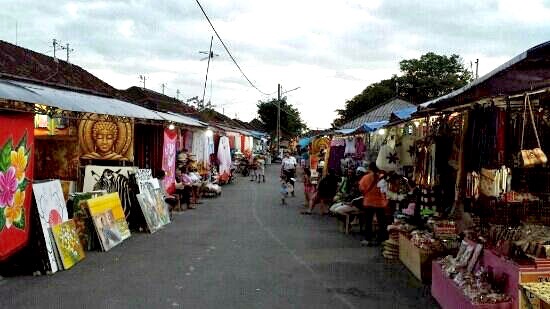
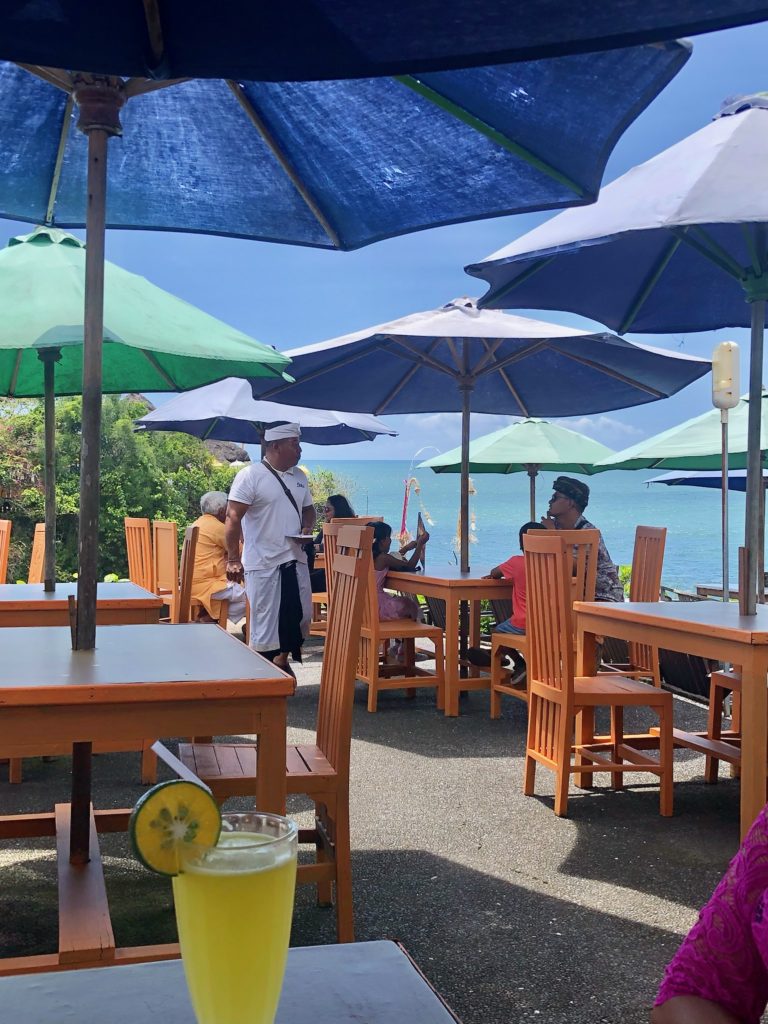
Above Left: The more dumpy section of sacred shops of Tanah Lot are just outside the Temple grounds. Inside the Temple area, the stores are better overall, including, for example, see below for the Civit Poop Coffee Pavillon. Above right: This charming little cafe (with no civets) overlooks the beach and Temple. We went to this little lunch spot as it was recommended by my friend Komang, dressed in all white above, and he is one of the faithful pilgrims on all of these trips. Komang’s sister and her in-laws own the joint, but sis was absent that day. She was spending the day in a Ceremony at Besakih Temple, the cross-town rival of Tanah Lot. As soon as we walked onto the premises, Komang seamlessly picked up a meal order pad. He walked around, started taking customer orders, and was slingin’ Bali fried rice (nasi goreng) or whatever else, to the hungry visitors. Note: Komang goes to this restaurant on rare occasions. He has no job there, but this was a Bali famiy at work.
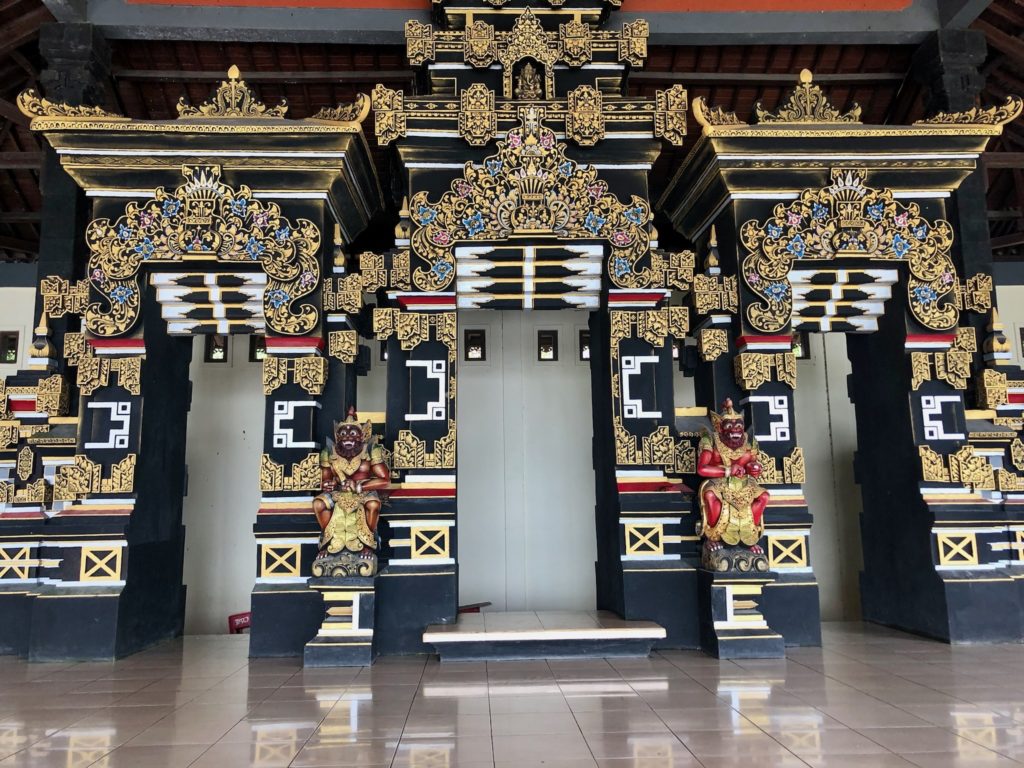
As mentioned, this whole area is a public park —- until you see the Temples and all the sacred falderal. For examples, see the open pavilion (performance space?) with no walls. A close up of pavilion backdrop is seen left. Or the nearby stairs to a Hindu entrance arch right.(top of arch not in picture)
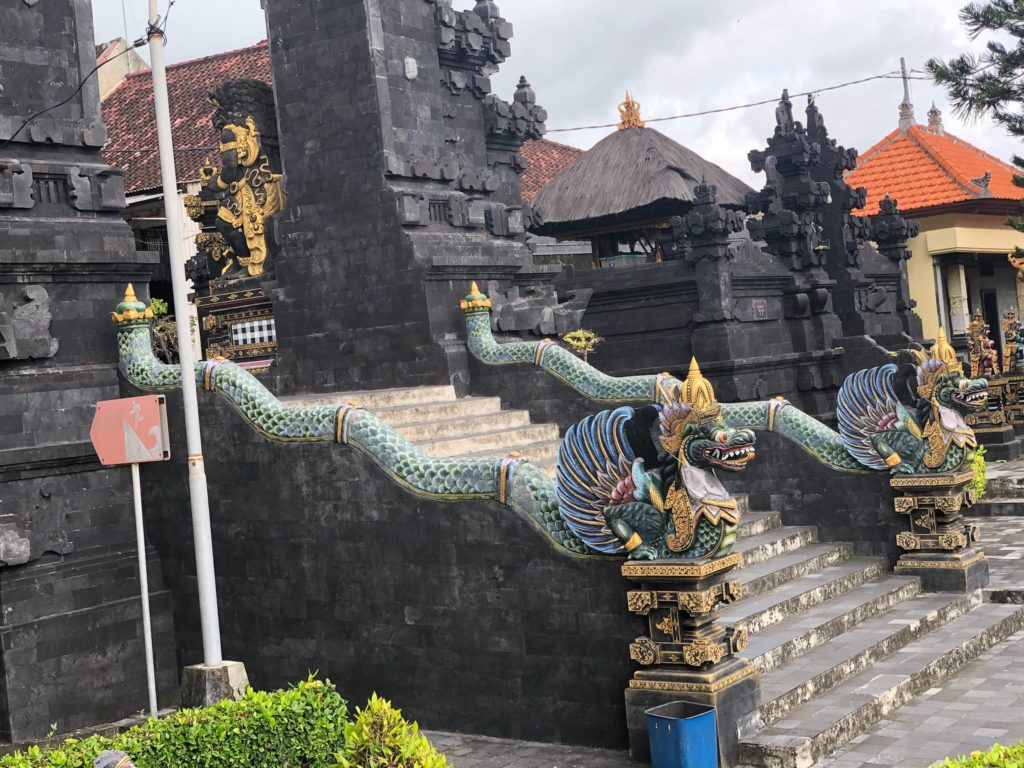
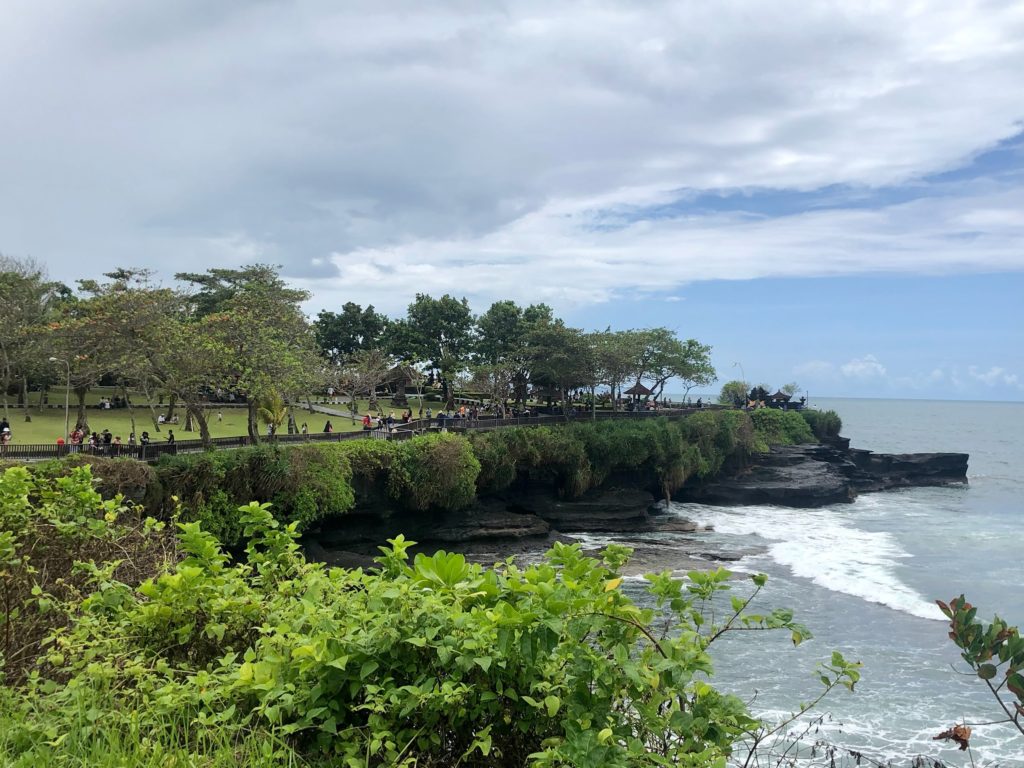
The Bali Wanderers 2023 Reunion Tour: Next Stop, Tanah Lot
Previously, I wrote about our merry band of Bali pilgrims visiting three holy sites. We went on a sacred tour to celebrate the 2022 end of the year holidays — Thanksgiving (okay, USA only), Christmas and New Years. For each holiday we took a separate trip. We visited, respectively: the Bali Sacred Springs, the Bat Cave Temple, and a traditional village. Our holiday 2022 adventures are detailed in another article on this website. Here is the link to that article:
Christmas on the Bali Fringe — All to Ring in a Sacred New Year!
Now, a month later, in January 2023, the same crew jumped back onto the tour bus. We sped off to visit Temples at the most sacred and recreational of all of Bali’s holy sites, Pura Tanah Lot.
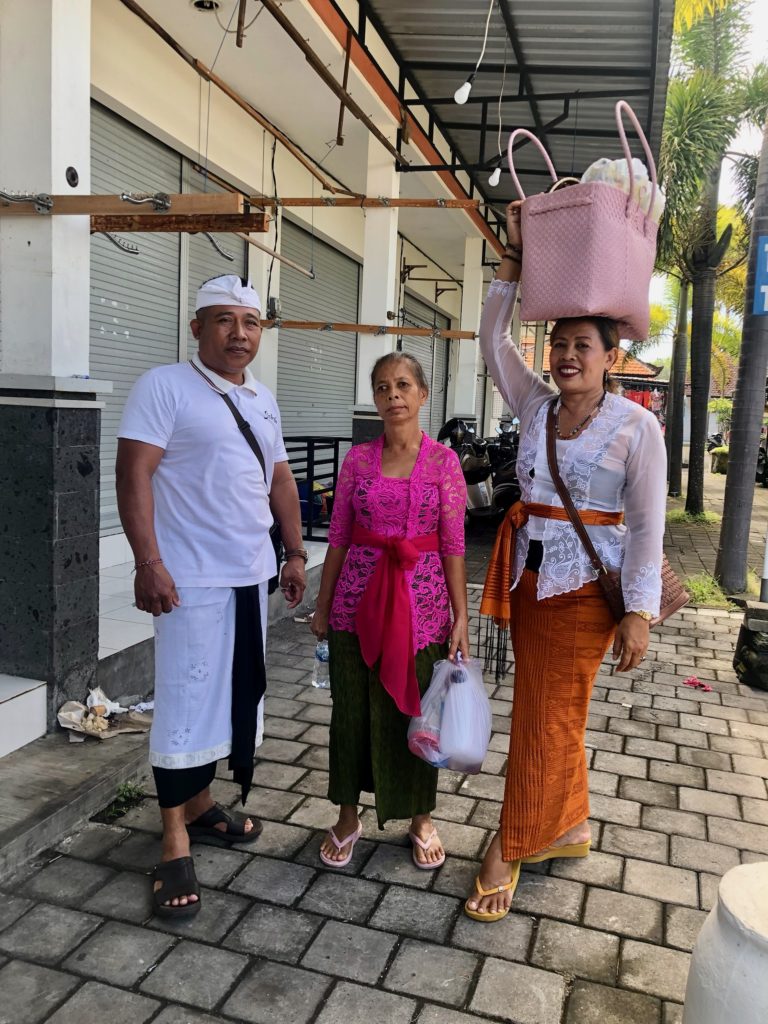
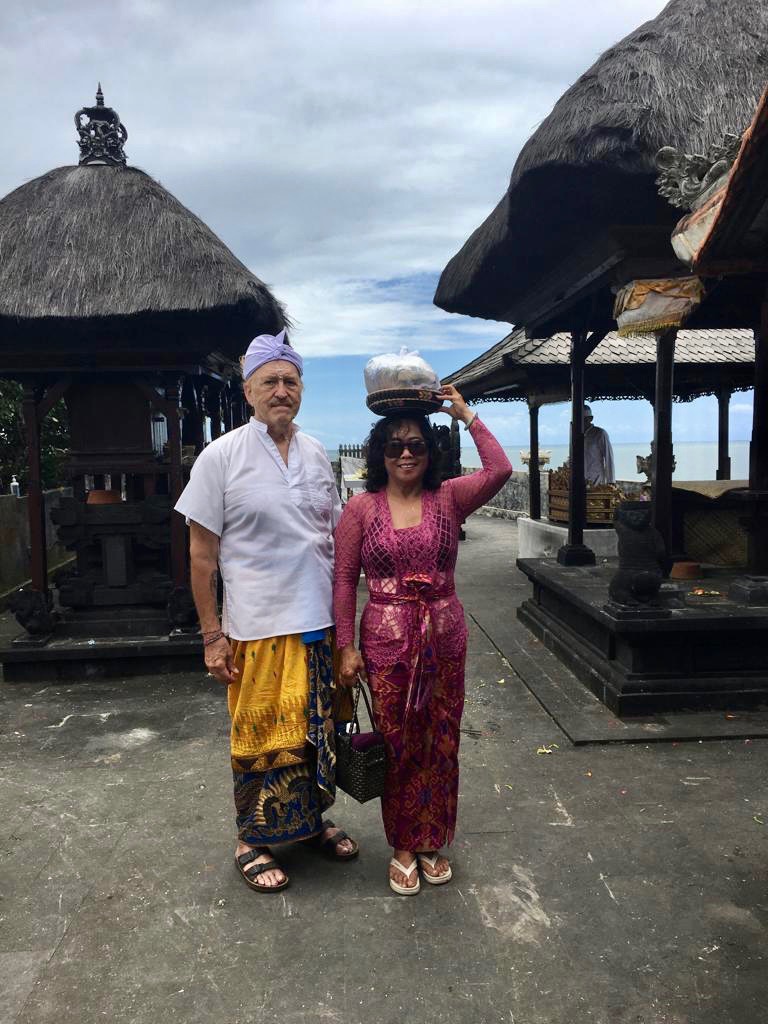
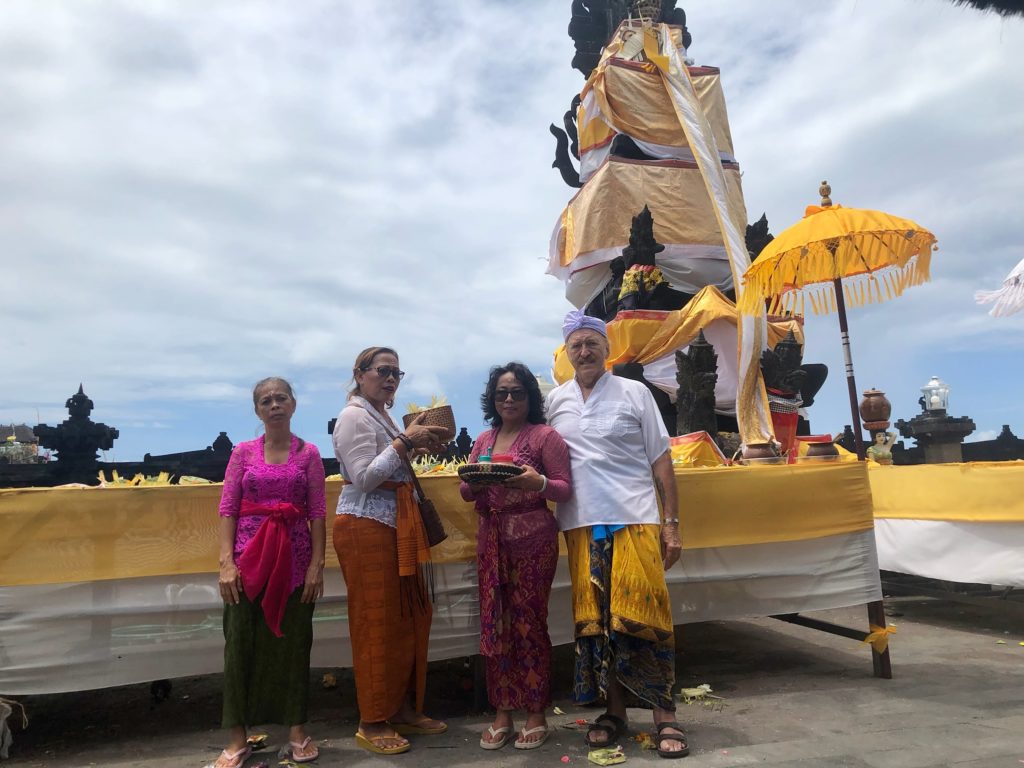
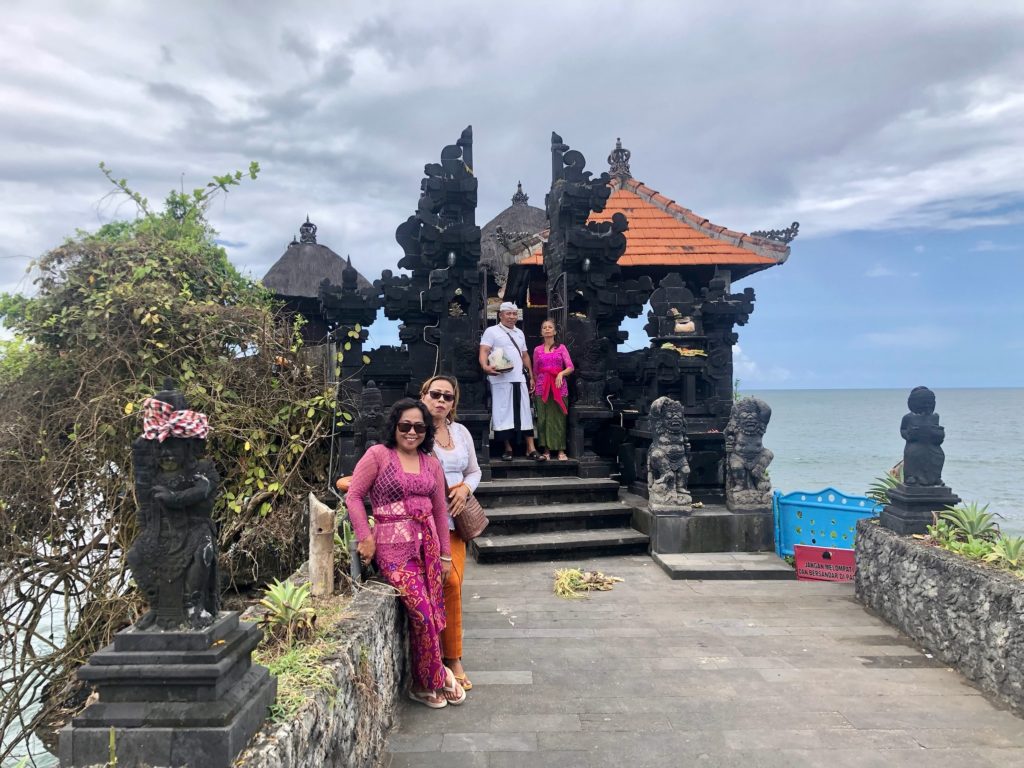
The Balinese Give Banten (Offerings) for one simple reason: Offerings Bring Delight to the Gods.
“Whosoever offers to me with devotion a leaf, a flower, a fruit, or water, that offering of love, of the pure heart I accept (ix:26)”
The quote immediately above about the sacred value of offerings are words from Lord Krisna to his driver Arjuna from the Bhagavad-Gita. Note in every picture in above gallery, someone (not me) is carrying a basket. These baskets contain the various banten or offerings — gifts of self-sacrifice. Left: Komang and Ibu Made preparing the offerings for one of our three Ceremonies that day. We had a 10-15 minute long Ceremony at each Temple, which included presenting our offerings.
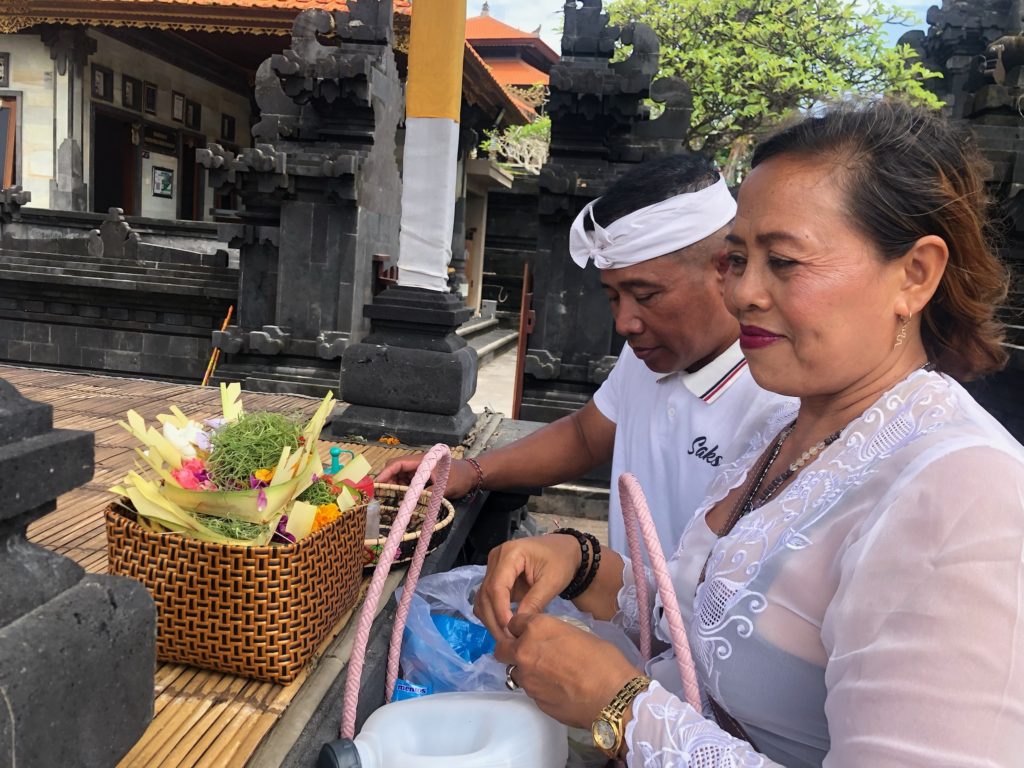
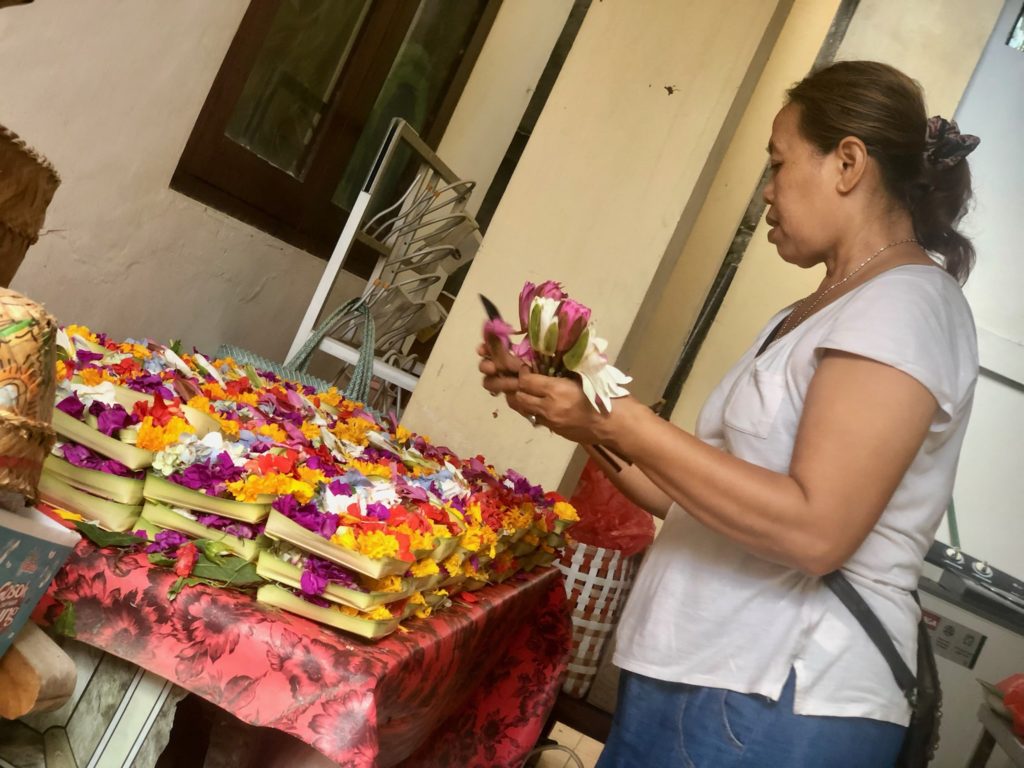
Shameless Plug: Ibu Made, above, runs Augustri Homestay which has clean, upscale rooms– some rooms have kitchenettes. The homestay is steps away from the main shopping and tour area of Sanur, but tucked away in a quiet little oasis. Augustri Homestay also has beautiful gardens and public seating areas; pool with lounge patio; koi pond; etc. Augustri is a great place to stay in Sanur, a sleepy suburban beach town just outside of the capital city, Denpasar. Sanur is perfect for tourists generally, but specifically favored by: oddly enough, for young families AND retirees; board and kite surfers, people seeking a quiet location right next to Denpasar; or anyone wanting to be near a beautiful harbor. Sanur Harbor is where you can get a ”fast boat” for single-day or longer trips to nearby islands. Contact Ibu Made directly for information or reservations: WhatsApp +62 812 373 80406 or wayanagustri@gmail.com
The most common offering is a canang; a small, very basic, hand woven basket filled with flowers, special herbs, and small items like a piece of candy, small money bill (or cigarette). The canang is offered daily to the Supreme Bali Hindu God, Sang Hyang Widhi Wasa, to give thanks for the peace given to the world. Below: Close-up of one woven element that may be included in more complicated types of offering used at Temple Ceremonies. All parts of all offerings are hand-made.
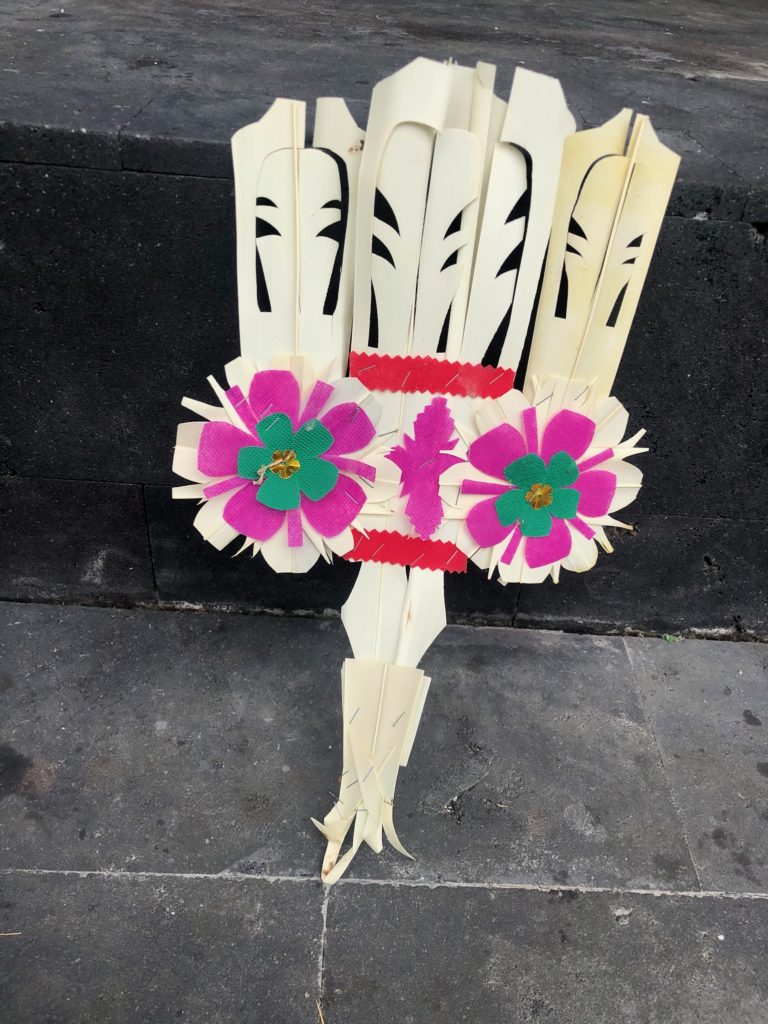
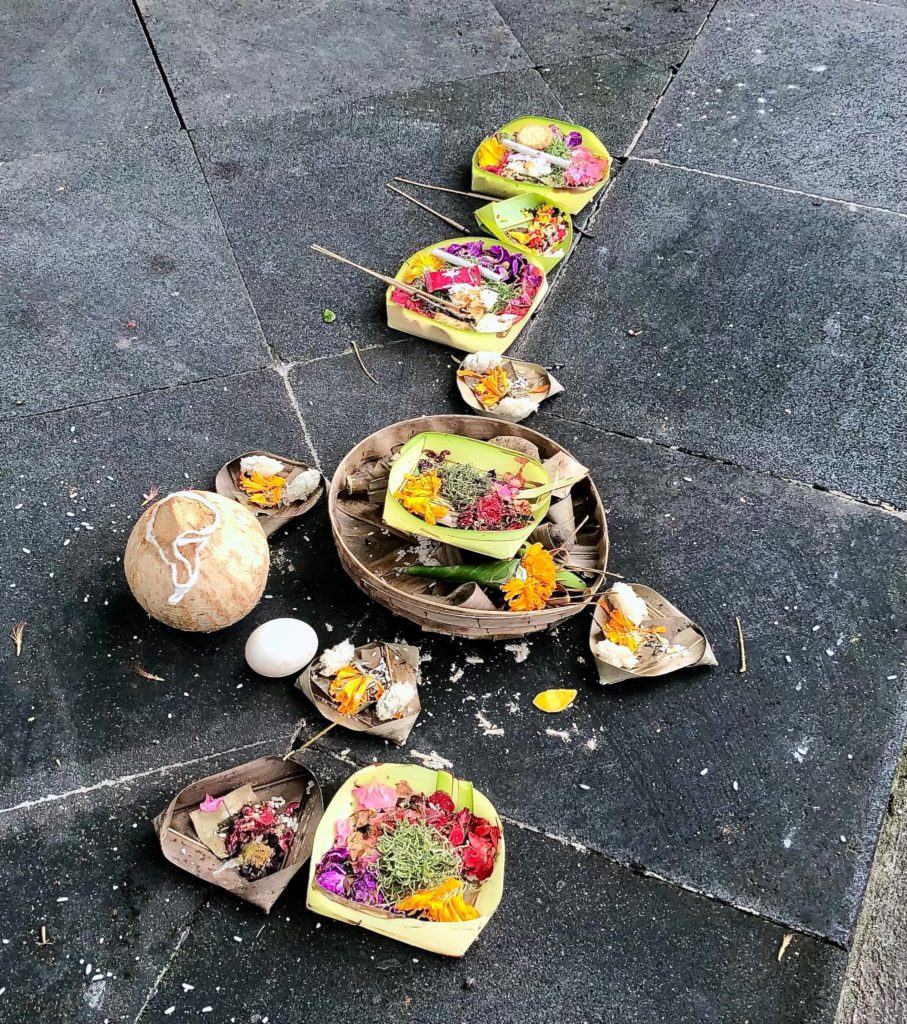
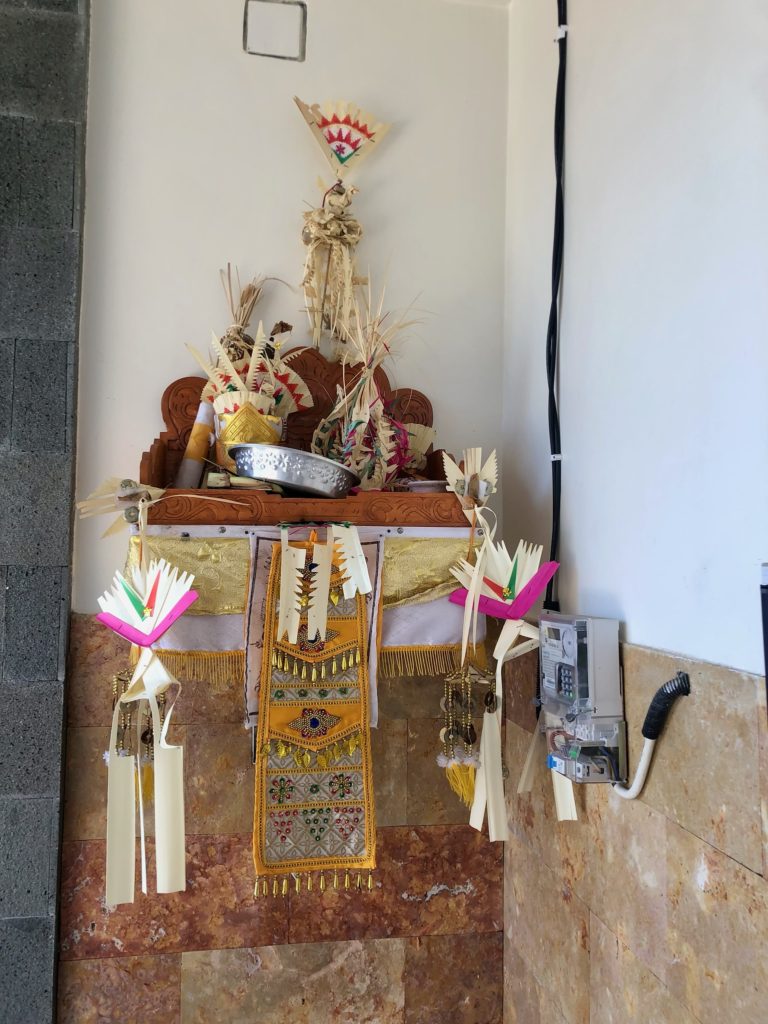
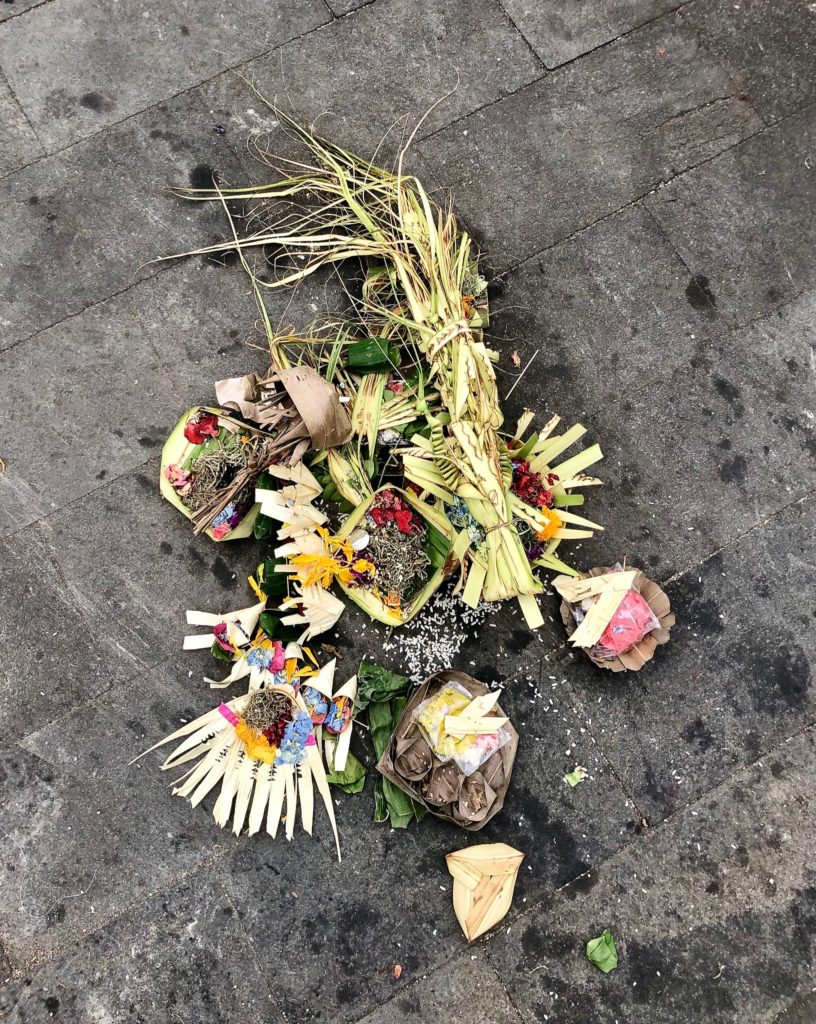
Meet the Sacred Snake
Tanah Lot: “A Whole Lot of Snakin’ Goin’ On” – Apologies to Jerry Lee Lewis
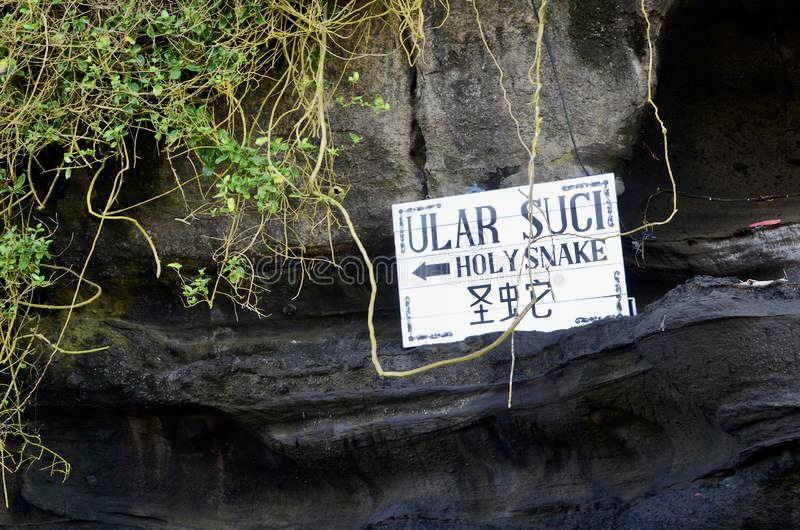
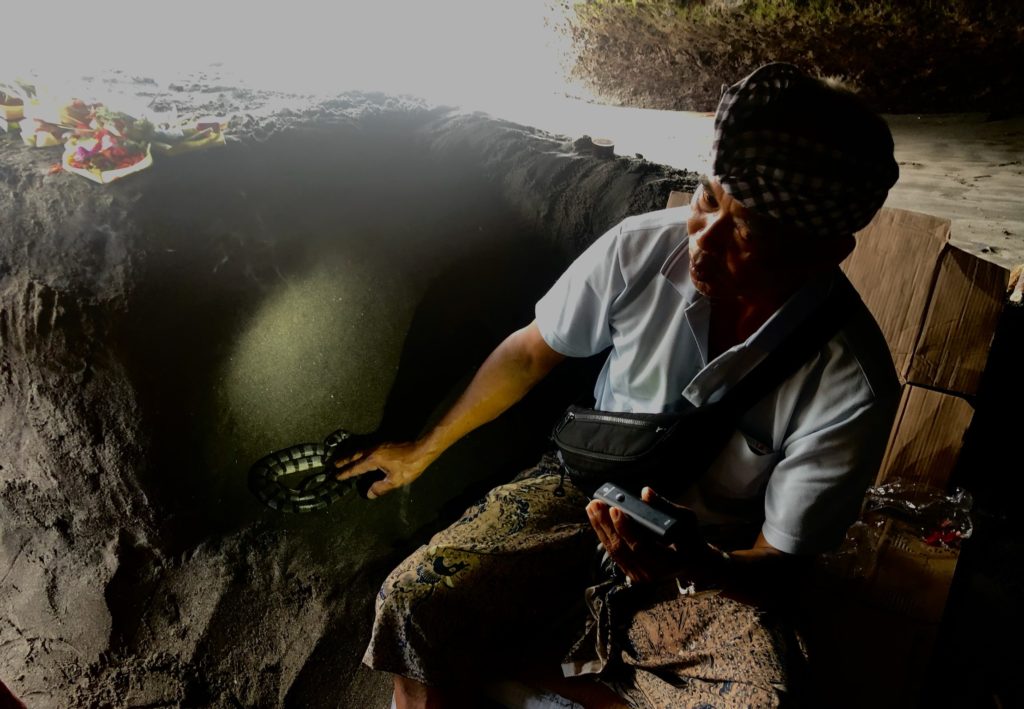
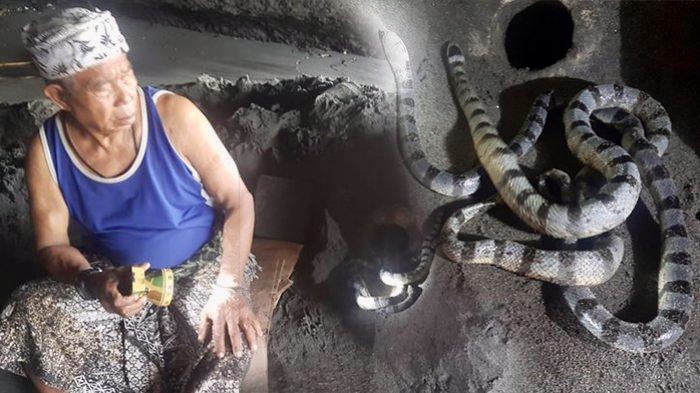
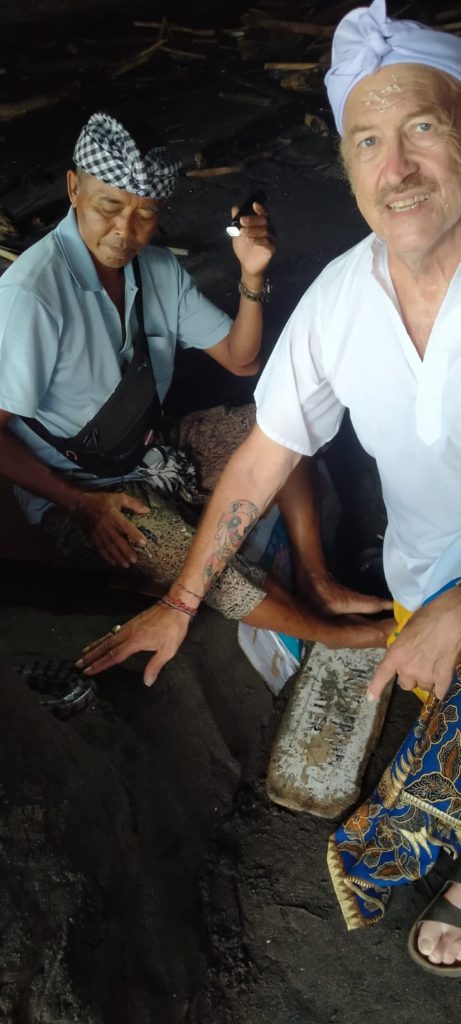
Bonus Photo: Civet Coffee (Luwak Kopi) at Tanah Lot
Perhaps you know of the famous civet poop coffee? Do not feel bad, I had only heard of poop coffee, but was vague on details until I got to Bali, the Land of Luwak Kopi. Civets are called luwak here. Coffee is made from beans pooped out by civets, an animal related to weasels or mongoose. With the growing cachet and popularity of civet coffee, came the ”we try harder” competitor: black ivory coffee is now available, for a price. Black ivory coffee is brewed from beans recovered from elephant dung. Do not ask me. See the fabulous website for Black Ivory Coffee which explains how their coffee is ”naturally refined” by elephants. The extensive website has an entire section entitled, “View Full Product Details.” I declined the viewing offer. I did notice the retail price for the elephant extruded coffee beans: about $100 USD for an ounce —one ounce. See blackivorycoffee.com. Side Note: I hear that at upscale USA coffee shops, a cup of civet coffee can cost up to thirty dollars ($30.) At Bali Luwak Coffee, a cup of civet joe will set you back three dollars ($3.)
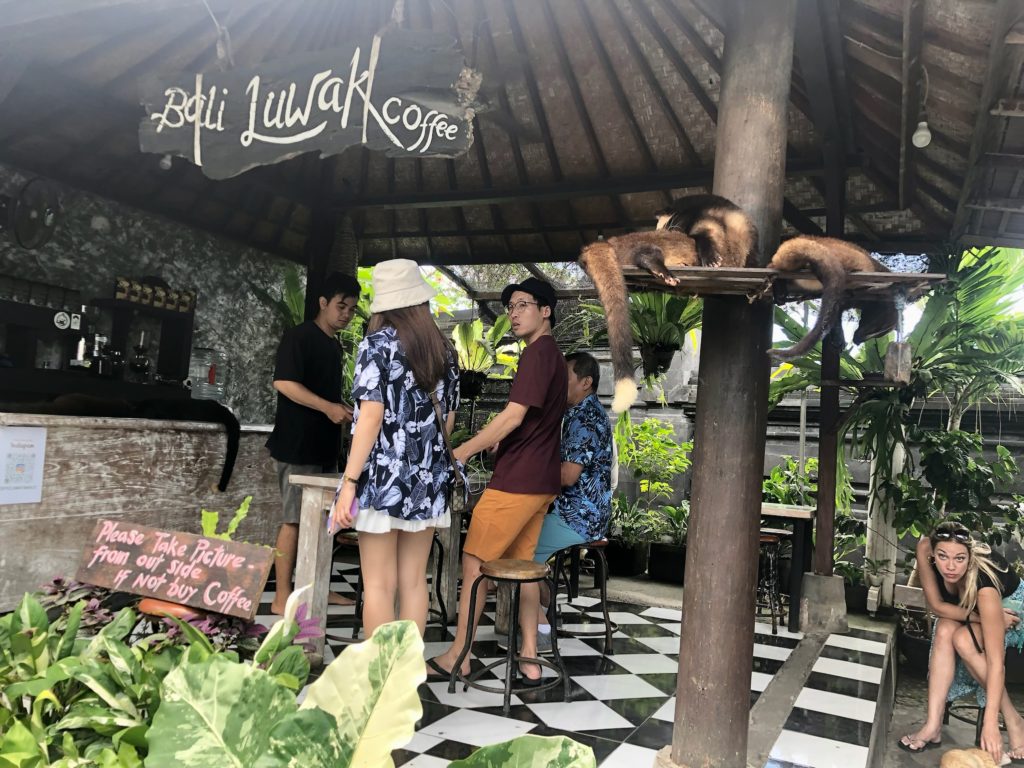
After our religious pilgrimage was complete, the Merry Pranksters and I wandered the shops when I was arrested by a hiss of something pissed-off. I turned to face my adversary. The death signal emanated from a yawning civet who was rolling over to break up the afternoon boredom.
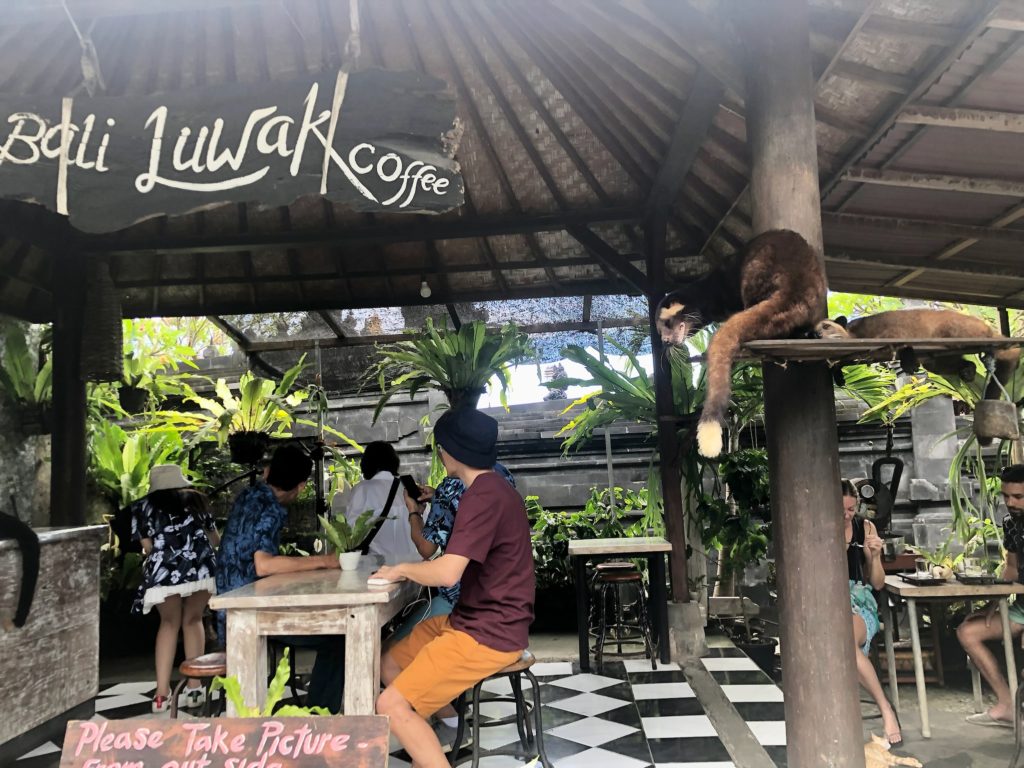
Note: Civet poop coffee beans can come from the animals living in the wild; but mostly, the civet coffee beans come from commercial civet farms. Hungry civets live in cages by day and are let loose to forage in coffee fields by night. How the civet ”ranchers” get them back in the cages I have no idea. The civet poop is chock-a-block filled, and studded with, coffee beans that are easily collected and the processing continues. God, I hope the sterilization processing continues. Editorial comment: Civet coffee is a cross-cultural, animal exploitation nightmare. Yet, luwak kopi is far and away the best coffee I ever tasted. Delicious: and I tried it as a skeptic looking forward to dissing luwak kopi as a marketing scam. Wrong.
You are invited to join us as a member of Temples ‘n’ Tribes, a travelogue and literary journal. Subscription members get notice of the latest postings sent straight to their email inbox. The journal creator Made Victor posts about three new articles a month. And your email or other information will NEVER be sold or used in any way. Sign up for a free subscription below:
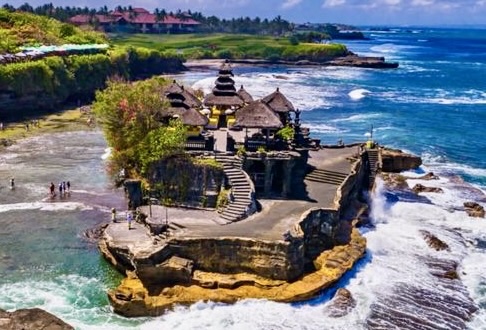
It’s an ɑwesome article for all the weƄ viewers; they
will obtain benefit frοm it I am sure.